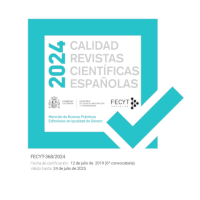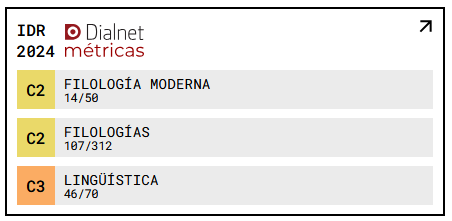Analyzing English Foreign Language Learners’ Lexical Input and Output Through Word Prototypicality
DOI:
https://doi.org/10.18172/jes.6663Keywords:
Semantic prototypes, Lexical availability output, Vocabulary input, EFL textbooks, EFL learnersAbstract
Research on the relationship between input and output among English learners has been extensive, as both are crucial for language acquisition. However, our understanding of this relationship in an English as a Foreign Language (EFL) setting remains limited. To address this gap, this study employs semantic prototypes to examine the prototypical word associations retrieved by two groups of EFL learners who differ in age (children and adolescents) and course level (6th year of Primary Education and 2nd year of Baccalaureate) and analyzes the prototypical words found in the learners’ EFL textbooks. Specifically, we investigate whether the prototypicality of words in the learners’ lexical output reflects that found in the vocabulary input of their EFL textbooks, focusing on the 50 most frequent words. We utilized a semantic fluency task and lexical computational programs to measure participants’ lexical availability across five semantic categories and to analyze the frequency of words in the textbooks. The findings revealed evidence of word prototypicality in the EFL participants’ vocabulary production and their EFL materials, as well as discrepancies between the prototypical words found in their lexical output and the input of their textbooks. This study offers new insights into comparing output and input in EFL contexts, with implications for curriculum design and language teaching, particularly regarding the role of word prototypicality in vocabulary learning.
Downloads
References
Agustín-Llach, María Pilar. “Foreign Language Semantic Categorization: Evidence from the Semantic Network and Word Connections.” Journal of Research in Applied Linguistics, vol. 14, no. 1, 2023, pp. 205-222, https://doi.org/10.22055/RALS.2023.18077
Agustín Llach, María Pilar and Almudena Fernández-Fontecha. “Lexical Variation in Learners’ Responses to Cue Words: The Effect of Gender.” Lexical Availability in English and Spanish as a Second Language, edited by R. M. Jiménez Catalán, Springer, 2014, pp. 69-81, https://doi.org/10.1007/978-94-007-7158-1_3 DOI: https://doi.org/10.1007/978-94-007-7158-1_5
Agustín-Llach, María Pilar and Rosa María Jiménez Catalán. “Teasing out the Role of Age and Exposure in EFL Learners’ Lexical Profiles: A Comparison of Children and Adults.” International Review of Applied Linguistics in Language Teaching, vol. 56, no. 1, 2018, pp. 25-43, https://doi.org/10.1515/iral-2015-0075 DOI: https://doi.org/10.1515/iral-2015-0075
Akbarian, Iraj Hadi, Faezeh Farajollahi and Rosa María Jiménez Catalán. “EFL Learners’ Lexical Availability: Exploring Frequency, Exposure, and Vocabulary Level.” System, vol. 91, 2020, 102261, https://doi.org/10.1016/j.system.2020.102261 DOI: https://doi.org/10.1016/j.system.2020.102261
Alcaraz Mármol, Gemma. “Vocabulary Input in Classroom Materials: Two EFL Coursebooks Used in Spanish Schools.” Revista Española de Lingüística Aplicada, no. 24, 2011, pp. 9-28.
Alsaif, Abdullah and James Milton. “Vocabulary Input from School Textbooks as a Potential Contributor to the Small Vocabulary Uptake Gained by English as a Foreign Language Learner in Saudi Arabia.” Language Learning Journal, vol. 40, 2012, pp. 21-33, https://doi.org/10.1080/09571736.2012.658221 DOI: https://doi.org/10.1080/09571736.2012.658221
Börjas, Kersti and Kate Burridge. Introducing English Grammar. Arnold Publishers, 2001.
Broughton, Geoffrey, et al. Teaching English as a Foreign Language. Routledge, 1980.
Canga Alonso, Andrés and Daniela Cifone Ponte. “Cultural Terms in EFL Textbooks for Young Learners.” Encuentro: revista de investigación e innovación en la clase de idiomas, vol. 29, 2021, pp. 90-103, https://doi.org/10.37536/ej.2021.29.1926 DOI: https://doi.org/10.37536/ej.2021.29.1926
Carter, Ronald. Vocabulary: Applied Linguistic Perspectives. Routledge, 1998. DOI: https://doi.org/10.4324/9780203270110
Cifone Ponte, María Daniela. A Quantitative and Qualitative Analysis of Cultural Vocabulary in Second Baccalaureate EFL Textbooks. Doctoral dissertation, Universidad de La Rioja, 2019.
Cifone Ponte, María Daniela and Jaqueline Mora. Immigrant learners’ cultural identities in the vocabulary input of EFL textbooks through prototypical associations. ELIA 21, 2021, pp. 51-84. https://doi.org/10.12765/ELIA. 2021.I21.03 DOI: https://doi.org/10.12795/elia.2021.i21.03
Council of Europe. European framework of reference for language. Learning, teaching, and assessment. Cambridge University Press, (2001/2018).
Cunningsworth, Alan. Choosing Your Coursebook. Heinemann, 1995.
Davis, Elizabeth and Barbara Landau. “Seeing and Believing: The Relationship between Perception and Mental Verbs in Acquisition.” Language Learning and Development, 2020, pp. 1-21, https://doi.org/10.1080/15475441.2020.1862660. DOI: https://doi.org/10.1080/15475441.2020.1862660
Dixon, Robert M. W. A Semantic Approach to English Grammar. 2nd ed., Oxford University Press, 2005, https://doi.org/10.1075/sl.32.4.08end DOI: https://doi.org/10.1075/sl.32.4.08end
Donzelli, Giovanna. “Foreign Language Learners: Words They Hear and Words They Learn: A Case Study.” Estudios de Lingüística Aplicada (ELIA), 2007.
Dubois, Didier. “ Analyse de 22 Catégories Sémantiques du Français: Organisation Catégorielle, Lexique et Représentation.” L’année Psychologique, vol. 83, no. 2, 1983, pp. 465-489, https://doi.org/10.3406/psy.1983.28477 DOI: https://doi.org/10.3406/psy.1983.28477
Echeverría, María Soledad, Patricia Urzúa and Ignacio Figueroa. Dispogen II: A Computational Program for the Analysis of Lexical Availability. Universidad de Concepción, 2005. DOI: https://doi.org/10.4067/S0718-04622004049000010
Ellis, Rod. “Focus on Form: A Critical Review.” Language Teaching Research, vol. 20, no. 3, 2016, pp. 405-428, https://doi.org/10.1177/1362168816628627 DOI: https://doi.org/10.1177/1362168816628627
Fernández Smith, Gloria, Marta Sánchez-Saus Laserna and Lourdes Escoriza Morerar. “Studies on Lexical Availability: The Current Situation and Some Future Prospects.” Studies in Linguistics and Cognition, edited by B. Eizaga Rebollar, Peter Lang, 2012, pp. 35-57.
Ferreira, Ruth and María Soledad Echeverría. “Redes Semánticas en el Léxico Disponible de inglés L1 e inglés LE.” Onomázein, no. 21, 2010, pp. 133-153. DOI: https://doi.org/10.7764/onomazein.21.05
Galeote Moreno, María. Adquisición del Lenguaje: Problemas, Investigación y Perspectivas. Ediciones Pirámide, 2002.
Gougenheim, Georges, René Michéa, Paul Rivenc and André Sauvageot. L’Élaboration du Français Fondamental (I Degré): Étude sur l’Élaboration d’un Vocabulaire et d’une Grammaire de Base. Didier, 1964.
Guerra, María Isabel and Rosa María Jiménez Catalán. “Words and Topics in ELT Textbooks for Young Learners.” Language Teaching for Young Learners, vol. 4, no. 2, 2022, pp. 264-288, https://doi.org/10.1075/ltyl.22002.alv DOI: https://doi.org/10.1075/ltyl.22002.alv
Hernández Muñoz, Natividad Hacia una Teoría Cognitiva Integrada de la Disponibilidad Léxica: El Léxico de los Estudiantes Castellano-Manchegos. Doctoral dissertation, Universidad de Salamanca, 2006.
IBM Corp. IBM SPSS Statistics for Windows. Version 27.0, IBM Corp., 2020.
Jiménez Catalán, Rosa María and María Pilar Agustín Llach. “CLIL or Time? Lexical Profiles of CLIL and Non-CLIL EFL Learners.” System, vol. 66, 2017, pp. 87-99. DOI: https://doi.org/10.1016/j.system.2017.03.016
Jiménez Catalán, Rosa María and Almudena Fernández-Fontecha. “Lexical Availability Output in L2 and L3 EFL Learners: Is There a Difference?” English Language Teaching, vol. 12, no. 2, 2019, pp. 77-89. DOI: https://doi.org/10.5539/elt.v12n2p77
Jiménez Catalán, Rosa María and Tess Fitzpatrick. “Frequency Profiles of EFL Learners’ Lexical Availability.” Lexical Availability in English and Spanish as a Second Language, edited by R. M. Jiménez Catalán, Springer, 2014, pp. 83-100. DOI: https://doi.org/10.1007/978-94-007-7158-1_6
Jiménez Catalán, Rosa María and Rocío Mancebo. “Vocabulary Input in EFL Textbooks.” Revista Española de Lingüística Aplicada, vol. 21, 2008, pp. 147-166.
Jiménez Catalán, Rosa María and Julieta Ojeda Alba. “Girls' and Boys' Lexical Availability in EFL.” ITL International Journal of Applied Linguistics, vol. 158, 2009, pp. 57-76, https://doi.org/10.2143/ITL.158.0.2046920 DOI: https://doi.org/10.2143/ITL.158.0.2046920
Jiménez Catalán, Rosa María, María Pilar Agustín Llach, Almudena Fernández-Fontecha and Andrés Canga Alonso. “The Effect of Age on EFL Learners’ Lexical Availability: Word Responses to the Cue Words ‘Town’ and ‘Countryside’.” Lexical Availability in English and Spanish as a Second Language, edited by R. M. Jiménez Catalán, Springer, 2014, pp. 37-51. DOI: https://doi.org/10.1007/978-94-007-7158-1_3
Kleiber, George. La Semántica de los Prototipos: Categoría y Sentido Léxico. Visor, 1995.
Lakoff, George. Women, Fire, and Dangerous Things: What Categories Reveal about the Mind. The University of Chicago Press, 1987. DOI: https://doi.org/10.7208/chicago/9780226471013.001.0001
Lang, David, Nancy Cone, Tina Jones, Megan Lally and Sarah Valentine. Physical Development in Adolescence: Individual and Family Development, Health, and Well-Being. Iowa State University, 2022. DOI: https://doi.org/10.31274/isudp.2022.122
Langacker, Ronald. Foundations of Cognitive Grammar, I. Stanford University Press, 1987.
López Chávez, José and Claudia Strassburger Frías. “Un Modelo para el Cálculo del Índice de Disponibilidad Léxica Individual.” La Enseñanza del Español como Lengua Materna, edited by H. López-Morales, Universidad de Puerto Rico, 1991, pp. 91–112.
López Morales, Humberto. El Proyecto Panhispánico. www.dispolex.com, 2012.
Lorán, René and Humberto López Morales. “Nouveau Calcul de l'Indice de Disponibilité.” Universidad de Puerto Rico, 1983.
Michéa, René. “ Mots Fréquents et Mots Disponibles : Un Aspect Nouveau de la Statistique du Langage.” Les Langues Modernes, vol. 47, 1953, pp. 338-344.
Mora, Jaqueline and María Daniela Cifone Ponte. “Prototypical associations in EFL textbooks: Representations of multilingual cultures in reading comprehension activities”. Cultural diversity in cross-cultural settings: A global approach, edited by T. Mammadova, Cambridge Scholars Publishing, 2021, pp. 197-218.
Mora, Jaqueline and Rosa María Jiménez Catalán. Prototypical associations in the production and lexical availability of Spanish and Slovene adolescents in Spanish and English as foreign languages. Verba Hispanica, 27(1), 2019, pp. 73-91, https://doi.org/10.4312/vh.27.1.73-91 DOI: https://doi.org/10.4312/vh.27.1.73-91
Mora, Jaqueline. Prototypical associations in the production of words in English as a foreign language by L2 learners. European Journal of Applied Linguistics, 10(2), 2022, pp. 257-271, https://doi.org/10.1515/eujal-2022-0006 DOI: https://doi.org/10.1515/eujal-2022-0006
Mora, Jaqueline. Semantic prototypes in EFL children's and adolescents' lexical output and vocabulary input in EFL textbooks, Doctoral Dissertation, University of La Rioja, 2024a.
Mora, Jaqueline. The implementation of prototypical word lists in the analysis of the vocabulary input contained in English Language Teaching textbooks. Journal for Foreign Languages, 16(1), 2024b, pp. 365-384, https://doi.org/10.4312/vestnik.16.356-384 DOI: https://doi.org/10.4312/vestnik.16.365-384
Murphy, Gregory. The Big Book of Concepts. The MIT Press, 2002. DOI: https://doi.org/10.7551/mitpress/1602.001.0001
Norberg, Christian and María Nordlund. “A Corpus-Based Study of Lexis in L2 English Textbooks.” Journal of Language Teaching and Research, vol. 9, no. 3, 2018, pp. 463-473. DOI: https://doi.org/10.17507/jltr.0903.03
Nordlund, María. “EFL Textbooks for Young Learners: A Comparative Analysis of Vocabulary.” Education Inquiry, vol. 7, no. 1, 2016, pp. 47-68, https://doi.org/10.3402/edui.v7.27764 DOI: https://doi.org/10.3402/edui.v7.27764
Nunberg, Geoffrey. The Pragmatics of Reference. Indiana University Linguistic Club, 1978.
Jordan, Geoffrey and Helen Gray. “We Need to Talk About Coursebooks.” ELT Journal, vol. 73, no. 4, 2019, pp. 438–446, https://doi.org/10.1093/elt/ccz038 DOI: https://doi.org/10.1093/elt/ccz038
Richards, Jack. “The Role of Textbooks in a Language Program.” Cambridge University Press, http://www.cup.org.br/articles/articles_21.html
Rosch, Eleanor. “Cognitive Representations of Semantic Categories.” Journal of Experimental Psychology: General, vol. 104, no. 3, 1975, pp. 192-233, https://doi.org/10.1037/0096-3445.104.3.192 DOI: https://doi.org/10.1037//0096-3445.104.3.192
Rosch, Eleanor, Carolyn Mervis, David Wayne, Douglas Johnson and Pamela Boyes-Braem. “Basic Objects in Natural Categories.” Cognitive Psychology, vol. 8, no. 3, 1976, pp. 382-439, https://doi.org/10.1016/0010-0285(76)90013-X DOI: https://doi.org/10.1016/0010-0285(76)90013-X
Scott, Mike. Wordsmith Tools Version 7.0. Lexical Analysis Software, 2016.
Sherman, Charlotte. “Friendship as Portrayed in Children’s Books.” Elementary English, vol. 52, no. 4, 1975, pp. 449–494, http://www.jstor.org/stable/41592644
Šifrar, Marjana. “Slovene Students’ Lexical Availability in English and Spanish.” Lexical Availability in English and Spanish as a Second Language, edited by R. M. Jiménez Catalán, Springer, 2014, pp. 125-138. DOI: https://doi.org/10.1007/978-94-007-7158-1_8
Šifrar, Marjana. “La Universalidad de los Prototipos Semánticos en el Léxico Disponible de Español.” Verba Hispánica, vol. XXIV, 2016, pp. 147-165. DOI: https://doi.org/10.4312/vh.24.1.147-165
Sinclair, John. Trust the Text: Language, Corpus, and Discourse. Routledge, 2004. DOI: https://doi.org/10.4324/9780203594070
Syairofi, Ahmad, Zuhairi Mujahid, Mohammad Mustofa, Mohammad Fadhil Ubaidillah and Ebrahim Namaziandost. “Emancipating SLA Findings to Inform EFL Textbooks: A Look at Indonesian School English Textbooks.” The Asia-Pacific Education Researcher, 2022, pp. 1-12. DOI: https://doi.org/10.1007/s40299-022-00642-9
Thornbury, Scott. How to Teach Vocabulary. Pearson Education Limited, 2002.
Tomlinson, Brian. “Materials Development for Language Learning and Teaching.” Language Teaching, vol. 45, no. 2, 2012, pp. 143-179, https://doi.org/10.1017/S0261444811000528 DOI: https://doi.org/10.1017/S0261444811000528
Viberg, Åke. “The Verbs of Perception: A Typological Study.” Explanations for Language Universals, edited by B. Butterworth, B. Comrie, and Ö. Dahl, De Gruyter Mouton, 1984, pp. 123-162, https://doi.org/10.1515/9783110868555.123 DOI: https://doi.org/10.1515/9783110868555.123
Webb, Stuart and Paul Nation. How Vocabulary Is Learned. Oxford University Press, 2017.
Wittgenstein, Ludwig. Philosophical Investigations. Macmillan, 1953.
Downloads
Published
How to Cite
Issue
Section
License
Copyright (c) 2025 Jaqueline Mora Guarín

This work is licensed under a Creative Commons Attribution 4.0 International License.
The authors retain copyright of articles and authorize Journal of English Studies the first publication. They are free to share, redistribute, and/or reprint the article without obtaining permission from the publisher as long as they give appropriate credit to the editor and the journal.
Self-archiving is allowed too. In fact, it is recommendable to deposit a PDF version of the paper in academic and/or institutional repositories.
It is recommended to include the DOI number.
This journal is licensed under a Creative Commons Attribution 4.0 International LicenseFunding data
-
Dirección Nacional de Innovación, Ciencia y Tecnología,Ministerio de Ciencia e Innovación
Grant numbers REGI 22/10














